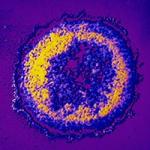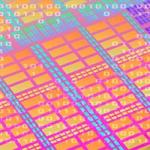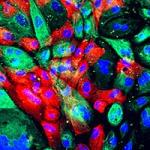
Myong-Hee Sung, Ph.D.
Stadtman Investigator
Laboratory of Molecular Biology and Immunology
NIA
Research Topics
The Transcription Systems Dynamics and Biology Unit applies quantitative single-cell imaging, mathematical, epigenomics, mouse genetics, and molecular biological approaches towards understanding the mechanisms of transcription factor signaling and functional genome regulation. We aim to uncover deeper insights into the systems basis of altered cell signaling and gene regulation in inflammatory conditions, neurodegeneration, and aging.
Single-cell approaches using fluorescent microscopy and mathematical modeling are necessary to decipher how transcription factors interpret and transmit the contextual information to downstream gene regulation. Fate-determining signaling information may be encoded in dynamic features of activity (such as frequency, duration, and amplitude), rather than biochemical features, for transcription factors that serve as signaling hubs. NF-κB is an important signaling hub for immunity and cell survival, which responds to diverse stimuli. It is a prototypical example of how quantitative single-cell analysis can lead to unexpected discoveries even for an extensively studied molecular system.
Breakthroughs in genomic tools have greatly expanded our ability to investigate chromatin characteristics that correspond to cell state-specific genome regulation. The current high throughput sequencing methods produce unprecedented amounts of epigenomic data. Putative regulatory regions in the genome can be predicted from DNase-seq or ATAC-seq data, both at the level of nucleosomes and at the nucleotide level, using statistically robust computational tools such as "DNase2TF" that detect transcription factor "footprints" without ChIP-seq. However, care is required for extracting meaningful information and patterns from the epigenomics data. We showed that the extent of footprint depth for transcription factors depends on their DNA binding residence times measured by live cell microscopy techniques such as single molecule tracking and FRAP (fluorescence recovery after photobleaching). This work revealed a previously unappreciated limitation of the genomic footprinting method regarding transcription factors with highly dynamic interactions with target chromatin.
We developed fluorescent knock-in mice that track one or both of the canonical subunits of NF-κB (Rahman et al. Cell Reports, 2022. PMID: 36417863), enabling applications from single-molecule analyses to in situ identification of active inflammatory cells. The knock-in reporter mice allowed us to find that the coordinated actions of two NF-κB subunits, namely the inflammatory signaling proteins RelA and c-Rel, help immune cells to determine the presence of specific microbes. RelA and c-Rel help these immune cells, called macrophages, distinguish the microbes via their shed pieces, as ligands for Toll-like receptors. This recognition produces a pathogen-tailored response. We discovered, by live-cell monitoring of macrophages from fluorescent double knock-in reporter mice, that RelA and c-Rel conveyed more information about ligands than either subunit alone. Based on this signaling information, we used machine learning to accurately predict which microbial ligands macrophages were responding to in a blind testing. The coordinated signaling between RelA and c-Rel may have developed during evolution. These findings provide insight into how NF-κB proteins mediate specific responses to a wide range of microenvironmental cues in immune cell communications (Rahman et al. Cell Reports, 2024. PMID: 38483906).
Biography
Dr. Sung received her Ph.D. in Mathematics from SUNY at Stony Brook and her postdoctoral training in Dr. James Yorke's nonlinear dynamics group at the University of Maryland, College Park. Dr. Sung transitioned to biology when she started in the bioinformatics group of Dr. Richard Simon at NCI, and then worked as a Staff Scientist for Dr. Gordon Hager, CCR/NCI, from 2005 to 2015 when she developed novel computational methodologies to analyze and extract biologically meaningful information from massive epigenomics data such as DNase-seq, ChIP-seq, and 4C. She began her independent investigator position at LMBI, NIA, Baltimore, in the fall of 2015.
Dr. Sung uses diverse systems biology approaches to study cell signaling dynamics and transcription control. Using mathematical modeling and optical imaging techniques, she revealed sustained asynchronous oscillations of NF-kappaB activity in individual cells exposed to a pro-inflammatory cytokine TNF-α. By using knock-in mice that express fluorescent NF-κB from the native locus and live cell imaging analysis, she observed that oscillations of NF-κB are sustained in TNF-α treated fibroblasts, raising questions as to what the function of oscillations is in various signaling contexts. Since this foundational work on the systems biology of NF-κB, her group has been investigating the real-time dynamics of NF-κB in macrophages, immune cells that can engulf bacteria upon sensing their molecular patterns. Her 2014 study published in Science Signaling showed that, above a critical dose, the bacterial component LPS results in the amplification of NF-κB through transcriptional activation of RelA, a ubiquitous subunit of NF-κB. This positive feedback helps overcome the various negative feedback loops and enable a full-blown innate immune response.
Selected Publications
- Rahman SMT, Singh A, Lowe S, Aqdas M, Jiang K, Vaidehi Narayanan H, Hoffmann A, Sung MH. Co-imaging of RelA and c-Rel reveals features of NF-κB signaling for ligand discrimination. Cell Rep. 2024;43(3):113940.
- Aqdas M, Sung MH. NF-κB dynamics in the language of immune cells. Trends Immunol. 2023;44(1):32-43.
- Rahman SMT, Aqdas M, Martin EW, Tomassoni Ardori F, Songkiatisak P, Oh KS, Uderhardt S, Yun S, Claybourne QC, McDevitt RA, Greco V, Germain RN, Tessarollo L, Sung MH. Double knockin mice show NF-κB trajectories in immune signaling and aging. Cell Rep. 2022;41(8):111682.
- Oh KS, Patel H, Gottschalk RA, Lee WS, Baek S, Fraser IDC, Hager GL, Sung MH. Anti-Inflammatory Chromatinscape Suggests Alternative Mechanisms of Glucocorticoid Receptor Action. Immunity. 2017;47(2):298-309.e5.
- Sung MH, Guertin MJ, Baek S, Hager GL. DNase footprint signatures are dictated by factor dynamics and DNA sequence. Mol Cell. 2014;56(2):275-285.
Related Scientific Focus Areas
This page was last updated on Monday, January 13, 2025




